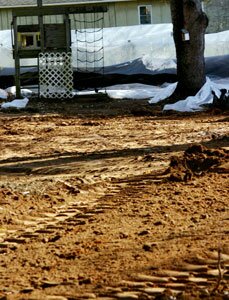Bitter fruit: Contaminated soil removed
With streets named Cling, York, and Winesap, Orchard Acres bears witness to Crozet's illustrious peach- and apple-growing history. A less savory reminder of the neighborhood's fruity past hit home last week when the Environmental Protection Agency began digging up arsenic-contaminated soil.
Barbara Peters was "furious and worried" when she came home November 10 and found a postcard notifying her that soil remediation would begin the following day at a house two doors down.
"I would have liked the opportunity to test my soil before that happened," she says. And she's not convinced soil removal is the best remedy for the high lead and arsenic levels found in spots around Crozet where, for decades, lead-arsenate was mixed to spray the fruit trees.
"There are things you can do without digging up the soil," she says. "That's the most dangerous."
Trish Taylor, EPA community involvement coordinator, agrees that there are several options when high levels are found, depending on how the land is used and who lives there.
The presence of three children at the targeted residence was key to the decision to remove the soil. The biggest risk of exposure? "Basically it's eating the dirt," says Taylor.
She declines to identify the owners of the house, citing privacy reasons, and says they've been relocated to a hotel for two weeks or so while the soil is removed.
Arsenic occurs naturally in soil, but the levels found at that house exceeded 50 parts per million, more than double the EPA screening levels of 20 to 25 ppm in residential areas. The EPA clean-up goal for the residence: 23 ppm or less.
"We did find elevated lead," says Taylor, "but it wasn't the driving factor."
Peters worries that in the course of removal, arsenic-contaminated dust could become airborne. Tarps cover the piles of dirt waiting to be hauled off, but November 16 was a windy day.
"We have air monitoring going on during the excavation," says Taylor. "We spray water to keep the dust down, and we also dry brush the tires of the trucks before they leave the site."
Contractors will dig up six to nine inches of dirt, and then sample the subsurface. Once that's confirmed clean by a Richmond lab, new fill dirt can be put in, explains Taylor. The contaminated soil is taken to a Richmond landfill.
Orchard Acres is the first remediation in Crozet, but the west side of Charlottesville is no stranger to soil removal. On October 28, heavy machines began digging up petroleum-soaked soil at a former Charlottesville Oil refueling site.
Other remediations could follow. Already, five residents near the Orchard Acres dig are requesting that the EPA sample their soil. And next on the EPA's list is to decide what to do with elevated levels at another orchard-turned-subdivision, Emerald Ridge.
Peters feels somewhat relieved after hearing from EPA representatives at a community meeting November 16, and she says public areas such as schools, playgrounds, and parks will be tested.
She's still concerned that so few neighbors were notified about the remediation– and the community meeting. A second one was scheduled for November 21.
Taylor says there are guidelines for notification at Superfund sites– but this isn't one. She estimates that 20 to 25 immediate neighbors were contacted by postcard.
And even as she speaks with the Hook, Taylor says, "I'm walking the neighborhood and putting out flyers to the entire Orchard Acres to notify them of the truck traffic."
One person relieved to see the digging going on is the owner of the house, who asks that his name not be used. "We're very glad the clean-up is happening, and we'll be glad to have the contaminated soil out of our yard," he says.
He and his wife, who've lived there since 1994, had been avid gardeners until a couple of years ago when they learned the arsenic level was high. (Taylor reports that the Agency of Toxic Substances and Disease Registry says vegetables grown in arsenic-laced soil are not an issue– just wash before eating.)
The family says they kept their sandbox full so the children had a safe place to dig, and they made sure the youngsters washed their hands.
"We did have the children tested for lead, and that came back low," says the father.
He's worried less about how the contaminated soil will affect his property values than about the health of his family. "I'm glad it's being done," he says.
And he tosses a bouquet to the EPA, lauding its "open and direct" communication. "They've been very responsive," he says.
Now if he can just get his family of five out of a hotel and back home.

High arsenic levels in the soil are more of a risk if children play outside, as was the case at this home in Crozet where the EPA is removing contaminated soil.
PHOTO BY GEORGE KAMIDE